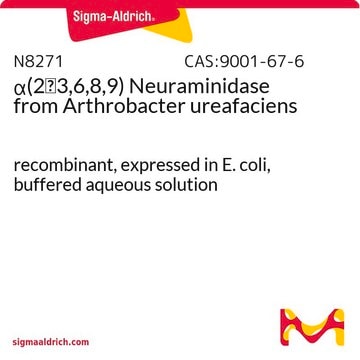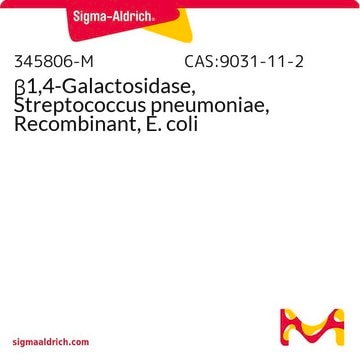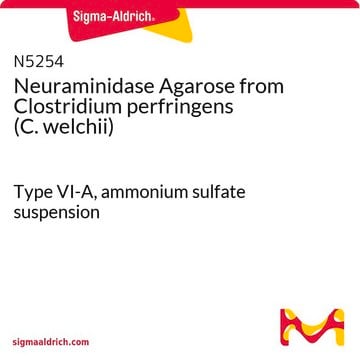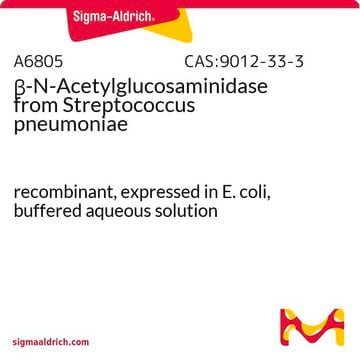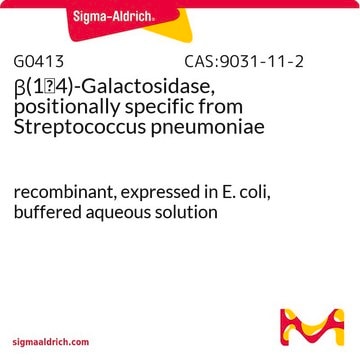It is shipped at ambient temperature, but it is to be stored at 2-8 °C for long term storage. Do not FREEZE as it is in a buffered aqueous solution.
N7271
α(2→3) Neuraminidase from Streptococcus pneumoniae
buffered aqueous solution
Synonym(s):
Acyl-neuraminyl Hydrolase, Acylneuraminyl hydrolase, Receptor-destroying enzyme, Sialidase
Select a Size
€1,070.00
Select a Size
About This Item
€1,070.00
Recommended Products
biological source
Streptococcus pneumoniae
Quality Level
form
buffered aqueous solution
concentration
≥5 units/mL
foreign activity
β-Galactosidase, α-mannosidase, β-hexosaminidase, α-fucosidase, and proteases, none detected
shipped in
wet ice
storage temp.
2-8°C
Gene Information
Streptococcus pneumoniae R6 ... nanB(933504)
Related Categories
Biochem/physiol Actions
Packaging
Unit Definition
Physical form
Preparation Note
Signal Word
Danger
Hazard Statements
Precautionary Statements
Hazard Classifications
Resp. Sens. 1
Storage Class Code
13 - Non Combustible Solids
WGK
WGK 1
Flash Point(F)
Not applicable
Flash Point(C)
Not applicable
Personal Protective Equipment
Choose from one of the most recent versions:
Already Own This Product?
Find documentation for the products that you have recently purchased in the Document Library.
Customers Also Viewed
Articles
Understand sialic acid structure, function, signaling, and modifications. Easily find products for sialic acid research.
-
What is the long term storage and shipping condition of ?(2—›3) Neuraminidase, Product No. N7271?
1 answer-
Helpful?
-
-
What is the molecular weight of ?(2—›3) Neuraminidase, Product No. N7271?
1 answer-
The molecular weight of this ?(2—›3 Neuraminidase enzyme is approximately 75 kDa.
Helpful?
-
-
What are the reaction conditions of the enzyme ?(2—›3) Neuraminidase, Product No. N7271?
1 answer-
One nanomole of substrate or less can be cleaved in a 20 μL reaction volume. In the standard reaction use: 4 μL of 5X enzyme reaction "buffer B" (=250 mM sodium phosphate buffer, pH 6.0), a combined volume of 14 μL containing purified oligosaccharide and water and 2 μL of NANase I (N7271). Incubate 1 hour at 37 °C. To cleave more than one nanomole of substrate, increase reaction volume and enzyme proportionally.
Helpful?
-
-
For ?(2—›3) Neuraminidase, Product No. N7271, what is the optimum pH range for the neuraminidase enzyme activity?
1 answer-
The optimum pH range for ?(2—›3 neuraminidase is 6.0. Please see the data sheet.
Helpful?
-
-
What is the Department of Transportation shipping information for this product?
1 answer-
Transportation information can be found in Section 14 of the product's (M)SDS.To access the shipping information for this material, use the link on the product detail page for the product.
Helpful?
-
Active Filters
Our team of scientists has experience in all areas of research including Life Science, Material Science, Chemical Synthesis, Chromatography, Analytical and many others.
Contact Technical Service


